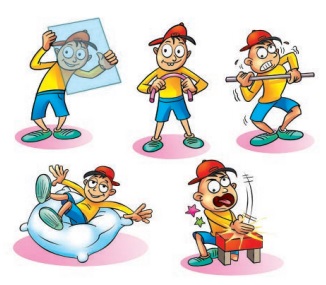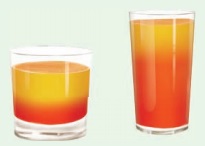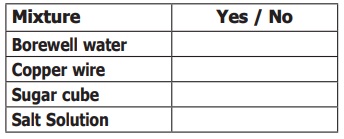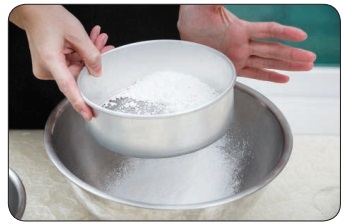Matter Around Us | Term 1 Unit 3 | 6th Science - Student Activities | 6th Science : Term 1 Unit 3 : Matter Around Us
Chapter: 6th Science : Term 1 Unit 3 : Matter Around Us
Student Activities
Activity – 1
Take a few crystals of sugar. Observe them carefully with the help of a magnifying lens.

Which of the shapes given above resembles a sugar crystal?
A B C D E F
Answer: D
Now place a few sugar crystals in a teaspoon full of water.
Answer: Like everything else a sugar crystal is also made up of molecules. When sugar dissolves in water, the sugar crystals break down and the molecules of sugar get distributed in the water. This makes the water taste sweet. The sugar molecules are extremely small, that is why we are not able to see them. A small amount of any matter will have many million molecules. (1 million = 1000000)
Like everything else a sugar crystal is also made up of molecules. When sugar dissolves in water, the sugar crystals break down and the molecules of sugar get distributed in the water. This makes the water taste sweet. The sugar molecules are extremely small, that is why we are not able to see them. A small amount of any matter will have many million molecules. (1 million = 1000000)
Activity 2
Sit together in groups of three. Look at the following objects. All these are familiar to you. Are they all the same or different? Can you pick out a few which you think are similar and group them? On what basis did you group them? Is there only one way of doing it or more ways? Discuss with your group members and note it down. You can group them according to their uses, the materials with which they are made of or some other properties and also as living and non-living things.
Activity 4
Lift an uninflated cycle tube. Inflate it and lift it again. Is there a change in the weight? Can we see that air has mass?
So we can say that air is also matter though we cannot see.
Let us try to know more about matter.
Test Yourself
Name an object which is brittle and transparent.
Name an object which can be stretched.
Name two objects which can be bent.

Activity 5
Let us take two sachets of juice. In both the sachets, it is written 100ml. Let us empty two sachets and pour the juice into the following glasses.

Does its shape also change? Yes / No
Answer: Yes
Does its volume change? when it is poured into a big glass or a small one? Yes / No
Answer: No
How will you find out whether the volume has changed or not?
Answer: A liquid needs a container and takes the shape of a container because the particles slide past one another and keep moving. The amount of juice is the same in both glasses. The volume of a liquid remains the same whether it is kept in a large container or a small one but its shape changes.
A liquid needs a container and takes the shape of a container because the particles slide past one another and keep moving. The amount of juice is the same in both glasses. The volume of a liquid remains the same whether it is kept in a large container or a small one but its shape changes.
Try to draw the shape of the liquid containers alone in your note book. What do you observe?
Answer: Its shape changes.
Try it yourself: Try to identify from the list what you think may be classified as mixture. Write yes if it is a mixture, then write No, if it is not a mixture. You may also write “I do not know” and later discuss with your teacher.

Activity 6
Think and find out!: Is it a good idea to separate bran from flour? Write your answer in your notebook

Answer: Yes, It is a good idea to separate bran from flour.
Activity-7
Have you seen how some farmers spread the dried grain stalks in the middle of the road? Heavy vehicles pass on them and the grains get separated from the stalks. Write down two merits and demerits of this practice.
Activity 8
Group Activity – Students are divided into 4 groups
Each group should suggest a method to separate mixtures and also give reasons why they used a particular method and what property of the components forms the basis for separation. Examples should be drawn from day-to-day life. After the group presents its method to the rest of the class, the whole class will discuss and analyse if the suggested method will work and then make a note of it in the form given below:

Activity 9
Collect and share information on common adulterants and their detection in food stuff in the class. Watch the youtube video: 10 simple tricks to find adulterated food. https://www.youtube.com/watch? v=_XLi WunnudY
Related Topics